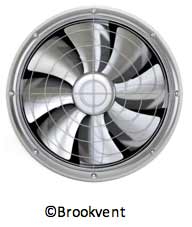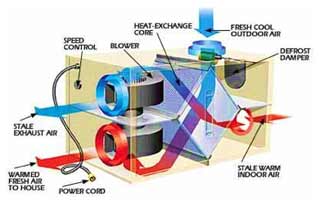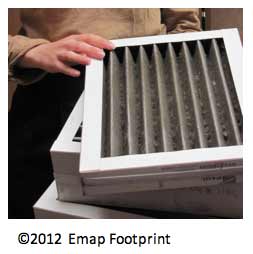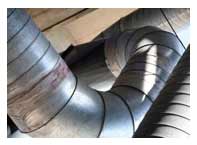With the drive today to cut greenhouse gases and reduce fossil fuel usage as much as possible, many new developments have been made in the renewable energy sector, particularly in area of saving energy.
In this guide we take a look at mechanical heat ventilation and recovery and how this works to recover heat that would otherwise be simply wasted.
Mechanical Ventilation and Heat Recovery: The Basics
Mechanical Ventilation and Heat Recovery (MVHR) systems use heat exchangers to transfer warmth from outgoing stale air to fresh incoming air, ensuring efficient energy use. They work using the following processes:
- Air Extraction: Stale air from inside your home is extracted through vents, usually located in moisture-prone areas like kitchens and bathrooms. This air is typically warmer due to heating and daily activities.
- Heat Exchanger: The extracted air passes through a heat exchanger, a crucial component of the HRV system. The heat exchanger transfers the heat from the outgoing air to the incoming fresh air without mixing the two air streams. This process ensures that the warmth is retained inside your home.
- Fresh Air Intake: Simultaneously, fresh air from outside is drawn into the system. As it passes through the heat exchanger, it is warmed by the heat recovered from the outgoing air. This pre-warmed air is then distributed throughout your home.
- Distribution: The warmed, fresh air is circulated through a network of ducts, maintaining a consistent indoor temperature and improving air quality. This continuous exchange ensures that your home remains well-ventilated and energy-efficient.
Indoor air is often eight to ten times more polluted than outdoor air. Traditional extractor fans in kitchens and bathrooms replace warm air with cold air, wasting energy. MVHR systems, however, are both efficient and economical.
MVHR systems can reclaim up to 90% of the heat from outgoing air, significantly reducing energy costs. In some instances there may also be grants available that will subsidise some of the installation and purchase costs, it’s worth looking into this.

Brookvent Heat Exchanger Fan
Is Heat Recovery Ventilation Worth it?
To know exactly whether such a system is suitable for a given space you really need to firstly look at the overall benefits and costs and how they may benefit in both the short term and long term such as immediate and long term savings and also improvements to living conditions, more on this below.
In answer to the question, is heat recovery ventilation worth it? For many homeowners, the answer is yes. The combination of energy savings, improved air quality, and environmental benefits make HRV systems a smart investment.
Investing in an HRV system not only enhances your living environment but also contributes to long-term savings and sustainability. With careful consideration of the initial costs and ongoing maintenance, an HRV system can be a valuable addition to any home, ensuring comfort and efficiency for years to come.
How Mechanical Ventilation and Heat Recovery Systems Work
When it comes to exactly how these systems work, MVHR systems come in two forms:
Single Room Heat Recovery Ventilator (SRHRV)
SRHRV systems are designed to ventilate individual rooms, typically bathrooms and kitchens. While they can be noisy, they bring in fresh air through trickle vents.
One issue with these systems is that in some cases they can reduce the insulation effectiveness in other parts of your home, so you need to be aware of this and the adverse effects it could have.
Whole House System
The Whole House System extracts warm, polluted air from spaces like bathrooms and kitchens through a ducting system and passes it through a heat exchanger, typically located in the loft or another hidden space.
The heat exchanger absorbs heat from the outgoing air and uses it to warm the incoming cold air that teh system sucks in from the outside. This heated air is then distributed throughout the house via ducts, providing fresh, warm air efficiently.
Other renewable heat technologies work similarly by using heat from various sources:
- Air Source Heat Pump: Extracts heat from the outside air. Easy to install and ideal for urban areas with limited space.
- Ground Source Heat Pump: Utilises ground heat through buried piping, requiring significant outdoor space.
- Water Source Heat Pump: Uses a submerged ground loop in a water source like a river or lake to extract heat.
Which system works best will ultimately depend on where you intend to install your system e.g. a single room or to cover an entire home or similar property.

Whole house heat recovery and ventilation system cross section
Costs of Installing Installing Mechanical Ventilation and Heat Recovery Systems
Installing a Mechanical Ventilation and Heat Recovery (MVHR) system can be a significant investment, but understanding the costs involved can help you make an informed decision and decide whether it’s worth it.
Here’s a detailed breakdown of what you can expect to spend on an MVHR system.
Initial Installation Costs
The average cost of installing an MVHR system ranges from £4,000 to £8,000. This price can vary based on several factors, including the size of your home, the type of system you choose, and the complexity of the installation.
For smaller or newer homes that are more airtight, the installation process tends to be simpler and, therefore, less expensive.
- System Size: Larger homes require more extensive ductwork and larger units, increasing the overall cost. Conversely, smaller homes can benefit from compact systems, which are generally more affordable.
- Type of System: There are different types of MVHR systems available, ranging from basic models to high-efficiency units with advanced features like smart controls and humidity sensors. High-end systems tend to cost more upfront but can offer better energy savings and performance over time.
- Installation Complexity: Installing ductwork in an existing home can be more challenging and expensive compared to new builds. Retrofitting an MVHR system may require additional work to accommodate the ducting, especially in older homes with limited space for installation.
Long-Term Savings
While the initial cost may seem high, an MVHR system can lead to substantial long-term savings.
By recovering up to 90% of the heat from outgoing air, these systems significantly reduce the need for additional heating, which can lower your energy bills.
Over time, these savings can offset the installation costs, making an MVHR system a cost-effective investment.
Maintenance and Running Costs
Maintaining an MVHR system is relatively low-cost. Regular maintenance, such as changing filters every three to six months, is essential to keep the system running efficiently.
The cost of replacement filters varies but is generally affordable and in most cases this can be done by the homeowner.
However, annual inspections by a professional can help ensure the system remains in good working condition, preventing costly repairs down the line.
Grants and Final Help Schemes
In some instances, there may be financial help available to help offset the cost of installing an MVHR system.
Programs like the Green Deal scheme, which unfortunately has now been stopped offered loans that could be repaid through energy savings, making it easier for homeowners to invest in energy-efficient technologies without a significant upfront expense.
Although many of these schemes have now been stopped due to the government pulling plug, it’s worth a little research in case you do qualify for any support.

Heat recovery and ventilation system pipework
Installing Mechanical Ventilation and Heat Recovery Systems
For an MVHR system to work effectively, your home needs to be relatively airtight. This makes MVHR systems ideal for smaller or newer homes.
What it comes to what’s involved in installing, here’s a run down on what’s involved to ensure a successful installation and also what you need to think about.
Planning and Design
The first step in installing an MVHR system is careful planning and design. Assess your home’s layout to determine the best locations for vents and the heat recovery unit.
Consider spaces like the kitchen, bathrooms, and other moisture-prone areas for extracting stale air.
The fresh air supply vents should be positioned in living areas and bedrooms. Working with a professional company that specialises in system design and installation will ensure you meet your specific needs and comply with and and all building regulations.
Consider the following key points:
- Ducting System: If your home lacks a ducting system, you’ll need to install one, which can be challenging in older homes with water-filled central heating systems.
- Home Insulation: An MVHR system works best in well-insulated, draught-proof homes. Without proper insulation, the system’s efficiency is compromised, making it less worthwhile.
- Concurrent Building Work: Installing an MVHR system alongside other building projects can reduce overall installation costs.
Choosing the Right System
Selecting the right MVHR system for your home is crucial. Systems vary in size and capacity, so it’s important to choose one that matches your home’s ventilation requirements.
Consider factors such as the size of your home, the number of rooms, and your climate. High-quality systems may have higher upfront costs but can offer better energy savings and durability in the long run.
Installation Process
Once you have considered on and settled with a system, it’s generally installed in the following way:
- Ductwork Installation: The duct-work is installed first generally. This involves running ducts from the extraction points in the kitchen and bathrooms or chosen installation rooms to the heat recovery unit, and from the unit to the fresh air supply points in living areas and bedrooms. Ensure ducts are well-insulated to prevent heat loss and condensation.
- Heat Recovery Unit Placement: Install the heat recovery unit in a suitable location, such as the loft, cellar, or a dedicated utility room. The unit should be easily accessible for maintenance and filter changes.
- Vent Installation: Install vents in the designated areas. Extract vents should be placed high on walls or ceilings in moisture-prone areas, while supply vents should be positioned in living spaces where fresh air is needed.
- Electrical Connections: Connect the MVHR system to the electrical supply. This should be done by a qualified electrician to ensure safety and compliance with any regulations.
- System Testing: Once the installation is complete, test the system to ensure it is working correctly. Check for proper airflow, make sure the heat exchanger is functioning, and verify that there are no leaks in the ductwork.
Maintenance and Operation
After installation, regular maintenance is essential for optimal performance of the system.
Change filters as recommended by the manufacturer, typically every three to six months, and schedule annual inspections to ensure the system remains efficient.
Understanding the operation of your MVHR system will help you get the most out of it, including setting appropriate ventilation rates and understanding how to adjust settings for seasonal changes.
The company that carries out your installation should give you full training on its use and how to keep it in tip-top condition.

Heat recovery and ventilation system pipework
MVHR Installation Time
The time it takes to install a Mechanical Ventilation and Heat Recovery (MVHR) system can vary depending on several factors.
Typically, the installation process can take anywhere from one to two days for smaller systems in new builds to several days for larger systems in existing homes.
Factors that influence installation time include the size and complexity of the system, the accessibility of installation locations, the need for ductwork installation, and any additional building work required.
It’s advisable to consult with a professional installer to get a more accurate estimate based on your specific circumstances.
Ideally, schedule the installation alongside other building work to streamline the process and reduce costs.
The Benefits of Mechanical Ventilation and Heat Recovery Systems
Installing MVHR systems offers numerous advantages, the most common of these are as follows:
- Exceptional Energy Efficiency: Manufacturers claim these units can recover up to 90% of lost heat in winter, significantly reducing energy consumption.
- Lower Carbon Emissions: By reclaiming renewable heat, these systems decrease reliance on traditional heating methods, thus reducing your carbon footprint.
- Improved Home Environment: MVHR systems filter out dust, steam, and cooking odours, enhancing indoor air quality. This can also reduce asthma triggers and create a more pleasant living space.
- Decreased Condensation: Extracting water vapour from bathrooms reduces condensation and humidity, leading to faster towel drying, improved overall room heating times and minimising mold growth.
- Reduced Heating Costs: By prolonging the interval between heating cycles, these systems can lower overall heating expenses.
- Cost Savings: Despite install installation outlay, long-term energy savings and the reduced maintenance needs of MVHR systems over other systems can result in hefty cost savings over time. Coupled with any grants that are available to assist with purchase and installation costs, you can get a system installed for relatively little outlay.
- Integration with Other Building Systems: In some cases it’s also possible to integrate MVHR systems with other building systems, such as smart home technology. By doing so, this can help to optimize energy efficiency and enhance overall building performance even more.
Although mechanical ventilation and heat recovery systems are fairly new, the technology is improving and refining all of the time, so if you do have the budget to afford to get such a system installed, if your home is up to scratch insulation-wise then you could reap the rewards!

